2020 full year EPS and cash flow from operations guidance ranges raised
Continued Responsiveness to COVID-19:
-
Ongoing support for employees, clients and communities across the country
-
Opened more than 1,800 test sites at drive-thru locations to date and continue to partner with federal, state and local officials
-
Launched Return Ready℠, a comprehensive COVID-19 business-to-business testing program
-
Consumer-driven health care model increases access to products and services
Second Quarter Year-over-Year Highlights:
-
Total revenues increased 3.0% to $65.3 billion
-
GAAP operating income increased 40.5% to $4.7 billion
-
Adjusted operating income (1) increased 32.2% to $5.3 billion
-
GAAP diluted earnings per share of $2.26
-
Adjusted EPS (2) of $2.64
Year-to-date Highlights:
-
Generated cash flow from operations of $10.4 billion
2020 Full Year Guidance:
-
Raised GAAP diluted EPS guidance range to $5.59 to $5.72 from $5.47 to $5.60
-
Raised Adjusted EPS (2) guidance range to $7.14 to $7.27 from $7.04 to $7.17
-
Raised cash flow from operations guidance range to $11.0 billion to $11.5 billion from $10.5 billion to $11.0 billion
WOONSOCKET, Rhode Island — CVS Health Corporation (NYSE: CVS) today announced operating results for the three months ended June 30, 2020.
CVS Health President and CEO Larry J. Merlo stated, “We’re a health innovation company that is built to meet the evolving needs of the millions we serve every day. That’s been made clear as we continue to navigate the health, social and economic impacts of COVID-19. Our earnings in this environment demonstrate the strength of our strategy and the power of our diversified business model.
“We have a strong foundation of clinical expertise, data analytics and digital capabilities, and unmatched consumer and community reach which has allowed us to rapidly bring our strategy to life at an unprecedented time. The environment surrounding COVID-19 is accelerating our transformation, giving us new opportunities to demonstrate the power of our integrated offerings and the ability to deliver care to consumers in the community, in the home and in the palm of their hand which has never been more important. We have stayed true to our purpose of helping people on their path to better health, and we remain focused on creating value for all our stakeholders.”
A summary of the Company’s response to the COVID-19 pandemic is included on page six.
The Company presents both GAAP and non-GAAP financial measures in this press release to assist in the comparison of the Company’s past financial performance with its current financial performance. See “Non-GAAP Financial Information” on page 12 and endnotes (1) and (2) on page 22 for explanations of non-GAAP financial measures presented in this press release. See pages 13 through 14 and page 21 for reconciliations of each non-GAAP financial measure to the most directly comparable GAAP financial measure.
Consolidated Second Quarter Results

-
Total revenues increased 3.0% in the three months ended June 30, 2020 compared to the prior year driven by growth across all segments. Total revenues in the three months ended June 30, 2020 were impacted by the COVID-19 pandemic, which adversely affected revenues in the Retail/LTC and Pharmacy Services segments primarily as a result of reduced new therapy prescriptions due to lower provider visits in the three months ended June 30, 2020, as well as reduced front store revenues in the Retail/LTC segment due to shelter-in-place orders.
-
Operating income and adjusted operating income increased 40.5% and 32.2%, respectively, in the three months ended June 30, 2020 compared to the prior year. The increase in both operating income and adjusted operating income was primarily due to the impact of the COVID-19 pandemic, which resulted in reduced benefit costs due to the deferral of elective procedures and other discretionary utilization in the Health Care Benefits segment, partially offset by reduced volume and increased operating expenses associated with the Company’s COVID-19 pandemic response efforts in the Retail/LTC segment.
-
Net income increased 54.6% in the three months ended June 30, 2020 compared to the prior year primarily due to the higher operating income described above, partially offset by higher income tax expense associated with the increase in pre-tax income.
-
The effective income tax rate was 24.6% for the three months ended June 30, 2020 compared to 25.5% for the three months ended June 30, 2019. The decrease in the effective income tax rate was primarily due to the favorable resolution of several state and local income tax matters in the three months ended June 30, 2020, partially offset by the reinstatement of the non-deductible Health Insurer Fee (“HIF”) for 2020.
Pharmacy Services Segment
The Pharmacy Services segment provides a full range of pharmacy benefit management solutions to employers, health plans, government employee groups and government sponsored programs. The segment results for the three and six months ended June 30, 2020 and 2019 were as follows:

-
Total revenues increased $47 million in the three months ended June 30, 2020 compared to the prior year, as growth in specialty pharmacy and brand inflation were largely offset by previously disclosed client losses and continued price compression.
-
Total pharmacy claims processed increased 3.4% on a 30-day equivalent basis in the three months ended June 30, 2020 compared to the prior year primarily driven by net new business, partially offset by reduced new therapy prescriptions due to lower provider visits in the three months ended June 30, 2020.
-
Operating income and adjusted operating income increased 6.2% and 2.4%, respectively, in the three months ended June 30, 2020 compared to the prior year primarily driven by growth in specialty pharmacy and improved purchasing economics. The increase was partially offset by continued price compression and previously disclosed client losses. The increase in operating income also was driven by lower amortization expense in the three months ended June 30, 2020.
See the supplemental information on page 16 for additional information regarding the performance of the Pharmacy Services segment.
Retail/LTC Segment
The Retail/LTC segment fulfills prescriptions for medications, provides patient care programs, sells a wide assortment of general merchandise, provides health care services through walk-in medical clinics, provides medical diagnostic testing and provides services to long-term care facilities. The segment results for the three and six months ended June 30, 2020 and 2019 were as follows:

-
Total revenues increased 1.0% in the three months ended June 30, 2020 compared to the prior year primarily driven by pharmacy drug mix, growth in retail pharmacy prescription volume and brand inflation. These increases were partially offset by continued reimbursement pressure, the impact of recent generic introductions, decreased long-term care prescription volume and lower front store revenues.
-
Front store revenues decreased 4.6% in the three months ended June 30, 2020 compared to the prior year. The decrease was primarily due to reduced customer traffic in the segment’s retail pharmacies due to shelter-in-place orders in response to the COVID-19 pandemic.
-
Prescriptions filled decreased 1.1% on a 30-day equivalent basis in the three months ended June 30, 2020 compared to the prior year. The decrease was primarily driven by reduced new therapy prescriptions due to lower provider visits in the three months ended June 30, 2020 and decreased long-term care prescription volume, partially offset by the continued adoption of patient care programs.
-
Operating income and adjusted operating income decreased 39.8% and 36.7%, respectively, in the three months ended June 30, 2020 compared to the prior year. The decrease in both operating income and adjusted operating income was primarily due to the impact of the COVID-19 pandemic, which resulted in incremental operating expenses associated with the Company’s COVID-19 pandemic response efforts, decreased front store volume and reduced new therapy prescriptions, as well as continued reimbursement pressure. These decreases were partially offset by improved generic drug purchasing in the three months ended June 30, 2020.
See the supplemental information on page 17 for additional information regarding the performance of the Retail/LTC segment.
Health Care Benefits Segment
The Health Care Benefits segment offers a full range of insured and self-insured (“ASC”) medical, pharmacy, dental and behavioral health products and services. The segment results for the three and six months ended June 30, 2020 and 2019 were as follows:

-
Total revenues increased 6.1% in the three months ended June 30, 2020 compared to the prior year primarily driven by membership growth in the Health Care Benefits segment’s Government products and the favorable impact of the reinstatement of the HIF for 2020. These increases were partially offset by the absence of the financial results of Aetna’s standalone Medicare Part D prescription drug plans (“PDPs”), which the Company retained through 2019, and membership declines in the segment’s Commercial insured products.
-
Operating income and adjusted operating income increased 188.7% and 140.9%, respectively, in the three months ended June 30, 2020, compared to the prior year. The increase was primarily driven by reduced benefit costs due to the deferral of elective procedures and other discretionary utilization in response to the COVID-19 pandemic, growth in the segment’s Government products and the impact of cost reduction efforts, including integration synergies. These increases were partially offset by membership declines in the segment’s Commercial insured products.
-
The Health Care Benefits segment’s MBR decreased 1,370 basis points from 84.0% to 70.3% in the three months ended June 30, 2020 compared to the prior year primarily due to the deferral of elective procedures and other discretionary utilization related to COVID-19 described above and the reinstatement of the HIF for 2020.
-
Medical membership as of June 30, 2020 of 23.6 million increased 124 thousand members compared with March 31, 2020, primarily reflecting increases in Medicare and Medicaid products, partially offset by a decline in Commercial products.
-
The Health Care Benefits segment experienced favorable development of prior-periods’ health care cost estimates in its Commercial and Government businesses during the three months ended June 30, 2020, primarily attributable to first quarter 2020 performance.
-
Prior years’ health care costs payable estimates developed favorably by $420 million during the six months ended June 30, 2020. This development is reported on a basis consistent with the prior years’ development reported in the health care costs payable table in the Company’s annual audited financial statements and does not directly correspond to an increase in 2020 operating results.
See the supplemental information on page 18 for additional information regarding the performance of the Health Care Benefits segment.
COVID-19 Response
CVS Health is uniquely positioned to help the country through the COVID-19 pandemic. The Company has focused its resources on the wellbeing and safety of employees, consumers and the communities it serves. The following are key actions taken to date:
Employees
-
Providing regular supply of personal protective equipment and adding safety features to retail stores.
-
Provided enhanced benefits, including bonuses to frontline employees, paid sick leave for part-time employees and paid time off to employees who test positive or are quarantined due to exposure.
-
Announced intention to hire 50,000 additional full-time, part time and temporary roles; over 40,000 hires to date.
Consumers and members
-
Waived cost sharing for COVID-19 diagnosis and treatment, including inpatient hospital admissions, for insured members.
-
Opened crisis response line for members experiencing anxiety related to COVID-19 and expanded 24/7 access to Aetna Nurse Medical line for Aetna and Caremark members.
-
Extended waivers for out-of-pocket costs for Aetna insured members for inpatient admissions for treatment or health complications associated with COVID-19 through September 30, 2020.
-
Extended waivers for cost-sharing for in-network telemedicine visits by Medicare Advantage members for outpatient behavioral and mental health counseling services through September 30, 2020.
-
Waived Medicare Advantage member out-of-pocket costs for all in-network primary care visits, whether done in-office or via telehealth, for any reason through September 30, 2020.
-
For Commercial members, waived cost sharing for minor acute care evaluation, care management services and certain behavioral health services rendered via telephone through December 31, 2020.
-
Expanded telehealth options (“E-Clinic”) offered by MinuteClinic to help patients access safe, affordable and convenient non-emergency care.
-
Extended maintenance prescriptions and waived early refill limits to support medication adherence.
-
Waived fees associated with prescription home delivery and associated front store products. Testing autonomous vehicle prescription delivery in collaboration with Nuro.
-
Sent care packages to members diagnosed with COVID-19 through Aetna’s Healing Better program
Plan Sponsors
-
Launched Return Ready, a comprehensive customizable and integrated end-to-end COVID-19 testing solution to assist employers and universities with the safe return of their employees, students and staff.
-
Provided assistance through premium credits.
Providers
-
Waived advance approvals, streamlined credentialing process, relaxed telemedicine policies and removed prior authorization requirements. Offering flexible plan designs to help reduce financial burdens.
Communities
-
Offering COVID-19 testing at over 1,800 CVS drive-thru locations, with more than 50% located in communities with significant need for support according to the CDC Social Vulnerability Index.
-
In coordination with the U.S. Department of Health and Human Services (“HHS”), opened 11 testing sites serving communities disproportionately impacted by the pandemic.
-
Launched critical diagnostic testing for the vulnerable senior population in long-term care facilities in partnership with 3 states.
-
Administered nearly 2 million COVID-19 tests nationwide through end of July.
-
Expanded Coram infusion services to help transition eligible IV-therapy patients to home-based care, freeing up hospital capacity.
-
Investing nearly $50 million directly and through the Company’s foundations to address food insecurity, lack of access to telehealth services for the underserved, personal protective equipment, mental health support for front-line workers and community resilience.
-
Returned all $43 million in funds received from the Coronavirus Aid, Relief, and Economic Security Act provider relief fund to HHS.
2020 Full Year Guidance
While acknowledging the inherent and unprecedented uncertainty surrounding the ongoing COVID-19 pandemic and its impact, the Company raised its full year 2020 GAAP diluted EPS guidance range to $5.59 to $5.72 from $5.47 to $5.60 and its full year 2020 Adjusted EPS guidance range to $7.14 to $7.27 from $7.04 to $7.17, reflecting an update to its estimated full year effective income tax rate. The Company projects higher utilization in its Health Care Benefits segment in the second half of 2020 than in the first half of 2020 and continued significant COVID-19 related investments, including operating costs, in the remainder of the year. The Company also raised its full year 2020 cash flow from operations guidance range to $11.0 billion to $11.5 billion from $10.5 billion to $11.0 billion.
The adjustments between GAAP diluted EPS and Adjusted EPS include adding back amortization of intangible assets, integration costs related to the Company’s acquisition (the “Aetna Acquisition”) of Aetna Inc. (“Aetna”) and expected gains/losses on divestitures.
Teleconference and Webcast
The Company will be holding a conference call today for investors at 8:00 a.m. (Eastern Time) to discuss its second quarter results. An audio webcast of the call will be broadcast simultaneously for all interested parties through the Investor Relations section of the CVS Health website at http://investors.cvshealth.com. This webcast will be archived and available on the website for a one-year period following the conference call.
About CVS Health
CVS Health employees are united around a common goal of becoming the most consumer-centric health company. We’re evolving based on changing consumer needs and meeting people where they are, whether that’s in the community at one of our nearly 10,000 local touchpoints, in the home, or in the palm of their hand. Our newest offerings — from HealthHUB® locations that are redefining what a pharmacy can be, to innovative programs that help manage chronic conditions — are designed to create a higher-quality, simpler and more affordable experience. Learn more about how we’re transforming health at www.cvshealth.com.
Cautionary Statement Concerning Forward-Looking Statements
The Private Securities Litigation Reform Act of 1995 provides a safe harbor for forward-looking statements made by or on behalf of CVS Health Corporation. Statements in this press release that are forward-looking include Mr. Merlo’s quotation, the information under the heading “2020 Full Year Guidance” and the information included in the endnotes and reconciliations. By their nature, all forward-looking statements are not guarantees of future performance or results and are subject to risks and uncertainties that are difficult to predict and/or quantify. Actual results may differ materially from those contemplated by the forward-looking statements due to the risks and uncertainties related to the COVID-19 pandemic, the geographies impacted and the severity and duration of the pandemic, the pandemic’s impact on the U.S. and global economies and consumer behavior and health care utilization patterns, and the timing, scope and impact of stimulus legislation and other federal, state and local governmental responses to the pandemic, as well as the risks and uncertainties described in our Securities and Exchange Commission (“SEC”) filings, including those set forth in the Risk Factors section and under the heading “Cautionary Statement Concerning Forward-Looking Statements” in our most recently filed Annual Report on Form 10-K, our Quarterly Report on Form 10-Q for the quarterly period ended June 30, 2020 and our recently filed Current Reports on Form 8-K.
You are cautioned not to place undue reliance on CVS Health’s forward looking statements. CVS Health’s forward-looking statements are and will be based upon management’s then-current views and assumptions regarding future events and operating performance, and are applicable only as of the dates of such statements. CVS Health does not assume any duty to update or revise forward-looking statements, whether as a result of new information, future events, uncertainties or otherwise.
– Tables Follow –
CVS HEALTH CORPORATION
Condensed Consolidated Statements of Operations
(Unaudited)
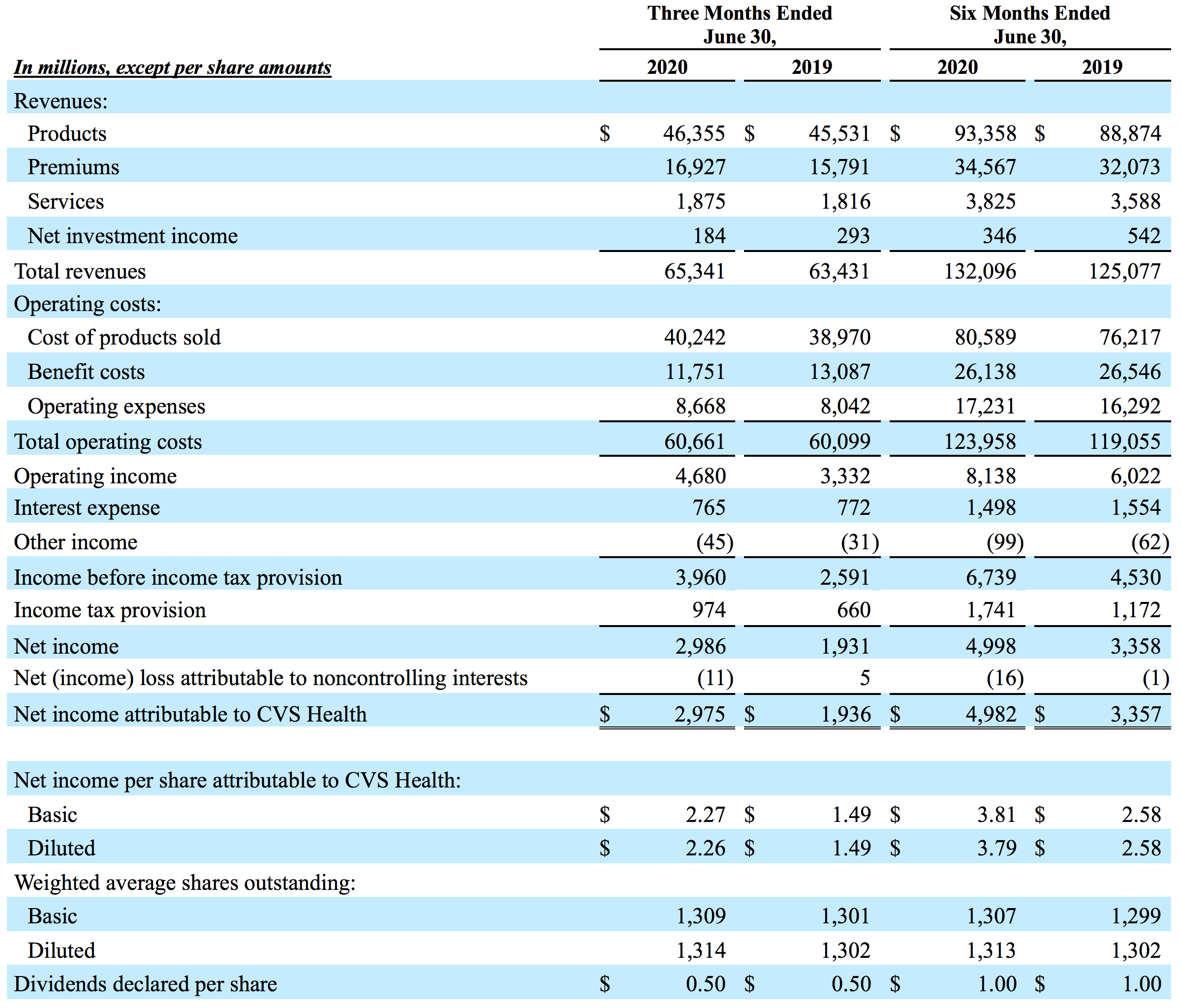
CVS HEALTH CORPORATION
Condensed Consolidated Balance Sheets
(Unaudited)
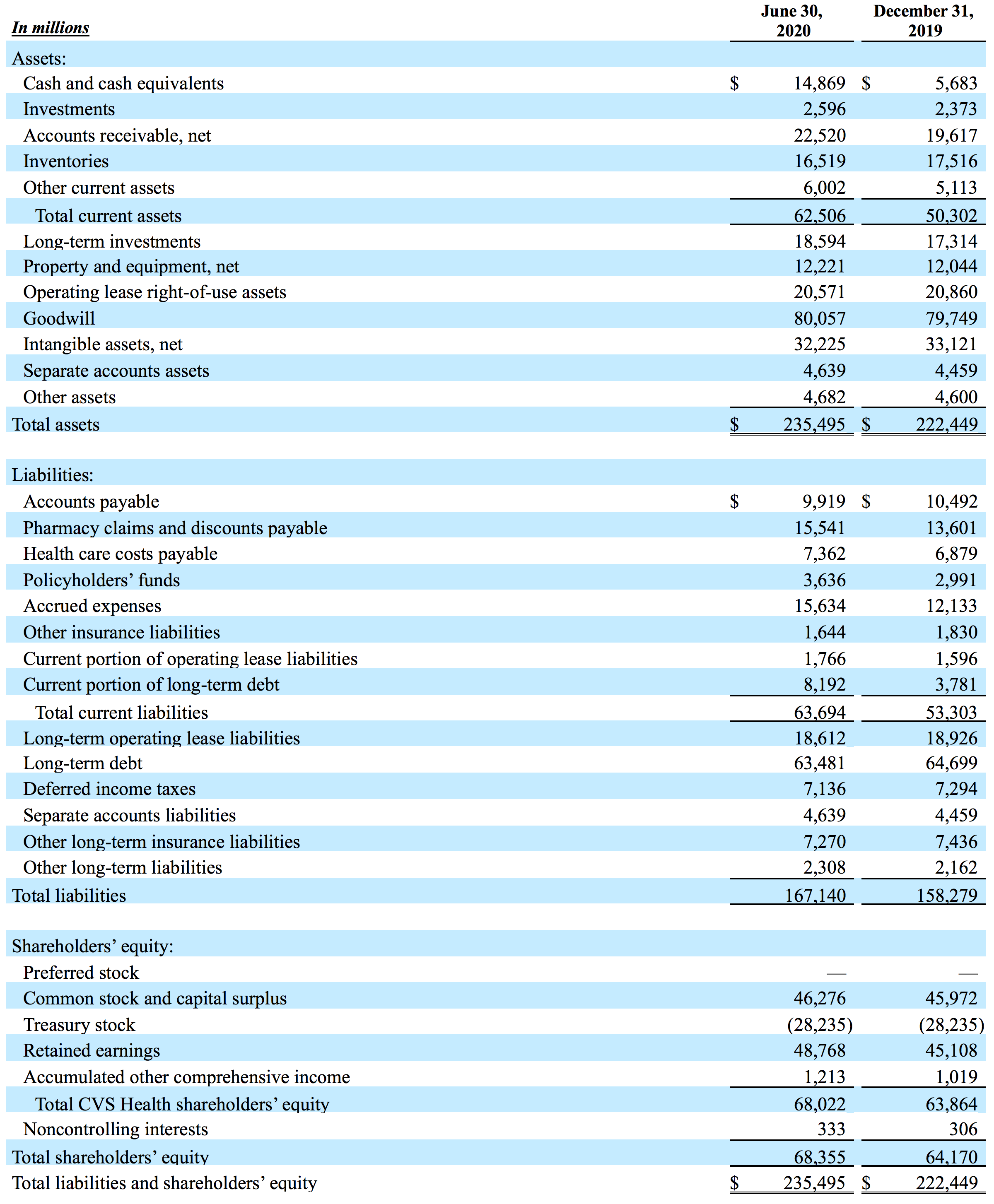
CVS HEALTH CORPORATION
Condensed Consolidated Statements of Cash Flows
(Unaudited)
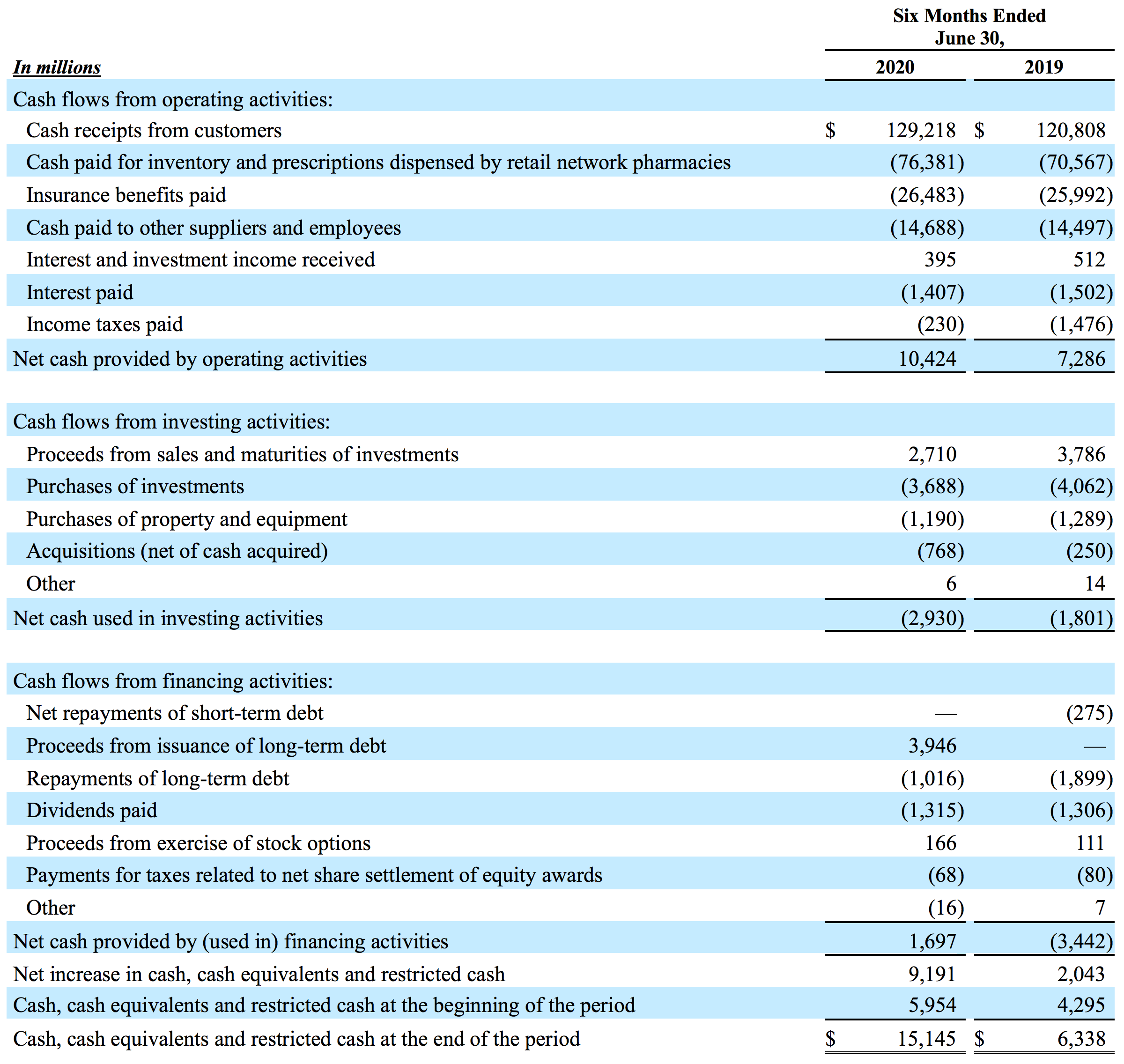
CVS HEALTH CORPORATION
Condensed Consolidated Statements of Cash Flows
(Unaudited)
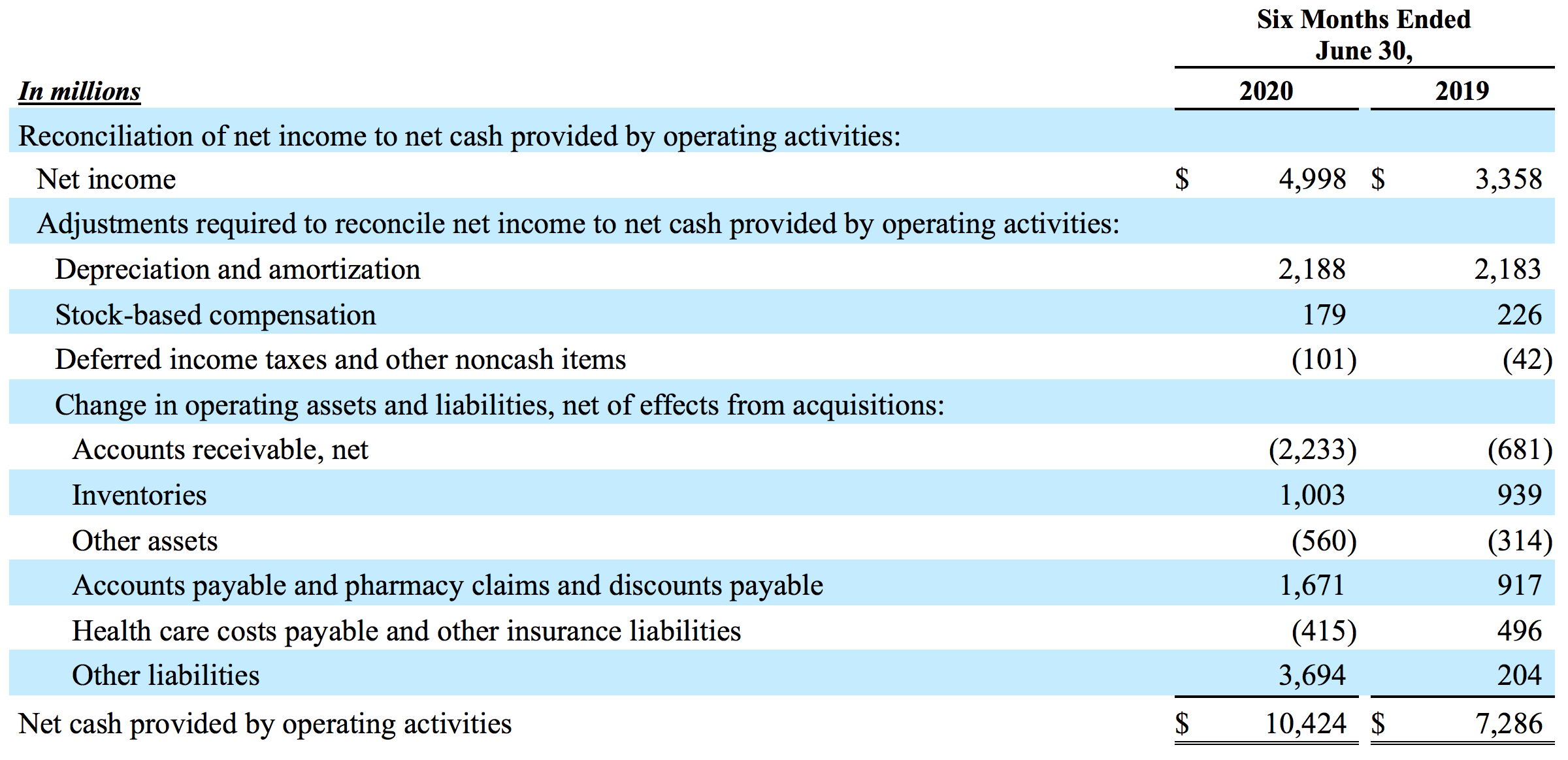
Non-GAAP Financial Information
The Company uses non-GAAP financial measures to analyze underlying business performance and trends. The Company believes that providing these non-GAAP financial measures enhances the Company’s and investors’ ability to compare the Company’s past financial performance with its current performance. These non-GAAP financial measures are provided as supplemental information to the financial measures presented in this press release that are calculated and presented in accordance with GAAP. Non-GAAP financial measures should not be considered a substitute for, or superior to, financial measures determined or calculated in accordance with GAAP. The Company’s definitions of its non-GAAP financial measures may not be comparable to similarly titled measures reported by other companies.
Non-GAAP financial measures such as adjusted operating income, adjusted earnings per share (EPS) and adjusted income attributable to CVS Health exclude from the relevant GAAP metrics, as applicable: amortization of intangible assets and other items, if any, that neither relate to the ordinary course of the Company’s business nor reflect the Company’s underlying business performance.
For the periods covered in this press release, the following items are excluded from the non-GAAP financial measures described above, as applicable, because the Company believes they neither relate to the ordinary course of the Company’s business nor reflect the Company’s underlying business performance:
-
The Company’s acquisition activities have resulted in the recognition of intangible assets as required under the acquisition method of accounting which consist primarily of trademarks, customer contracts/relationships, covenants not to compete, technology, provider networks and value of business acquired. Definite-lived intangible assets are amortized over their estimated useful lives and are tested for impairment when events indicate that the carrying value may not be recoverable. The amortization of intangible assets is reflected in the Company’s unaudited GAAP condensed consolidated statements of operations in operating expenses within each segment. Although intangible assets contribute to the Company’s revenue generation, the amortization of intangible assets does not directly relate to the underwriting of the Company’s insurance products, the services performed for the Company’s customers or the sale of the Company’s products or services. Additionally, intangible asset amortization expense typically fluctuates based on the size and timing of the Company’s acquisition activity. Accordingly, the Company believes excluding the amortization of intangible assets enhances the Company’s and investors’ ability to compare the Company’s past financial performance with its current performance and to analyze underlying business performance and trends. Intangible asset amortization excluded from the related non-GAAP financial measure represents the entire amount recorded within the Company’s GAAP financial statements, and the revenue generated by the associated intangible assets has not been excluded from the related non-GAAP financial measure. Intangible asset amortization is excluded from the related non-GAAP financial measure because the amortization, unlike the related revenue, is not affected by operations of any particular period unless an intangible asset becomes impaired or the estimated useful life of an intangible asset is revised.
-
During the three and six months ended June 30, 2020 and 2019, acquisition-related integration costs relate to the Aetna Acquisition. The acquisition-related integration costs are reflected in the Company’s unaudited GAAP condensed consolidated statements of operations in operating expenses within the Corporate/Other segment.
-
During the six months ended June 30, 2019, the store rationalization charge primarily relates to operating lease right-of-use asset impairment charges in connection with the planned closure of 46 underperforming retail pharmacy stores in the second quarter of 2019. The store rationalization charge is reflected in the Company’s unaudited GAAP condensed consolidated statement of operations in operating expenses within the Retail/LTC segment.
-
The corresponding tax benefit or expense related to the items excluded from adjusted income attributable to CVS Health and Adjusted EPS above. The nature of each non-GAAP adjustment is evaluated to determine whether a discrete adjustment should be made to the adjusted income tax provision.
The Company’s full year 2020 guidance reconciliation also reflects an estimated gain on divestiture of the Company’s Coventry Health Care Workers Compensation business, which the Company sold on July 31, 2020 for approximately $850 million. The Company expects to recognize a pretax gain on this divestiture of approximately $225 million within the Health Care Benefits segment in the third quarter of 2020. This amount has been excluded from the projected full year Adjusted EPS because the Company believes this amount neither relates to the ordinary course of the Company’s business nor reflects the Company’s underlying business performance.
See endnotes (1) and (2) on page 22 for definitions of non-GAAP financial measures. Reconciliations of each non-GAAP financial measure to the most directly comparable GAAP financial measure are presented on pages 13 through 14 and page 21.
Reconciliations of Non-GAAP Financial Measures to the Most Directly Comparable GAAP Financial Measures
Adjusted Operating Income
(Unaudited)
The following are reconciliations of operating income to adjusted operating income:
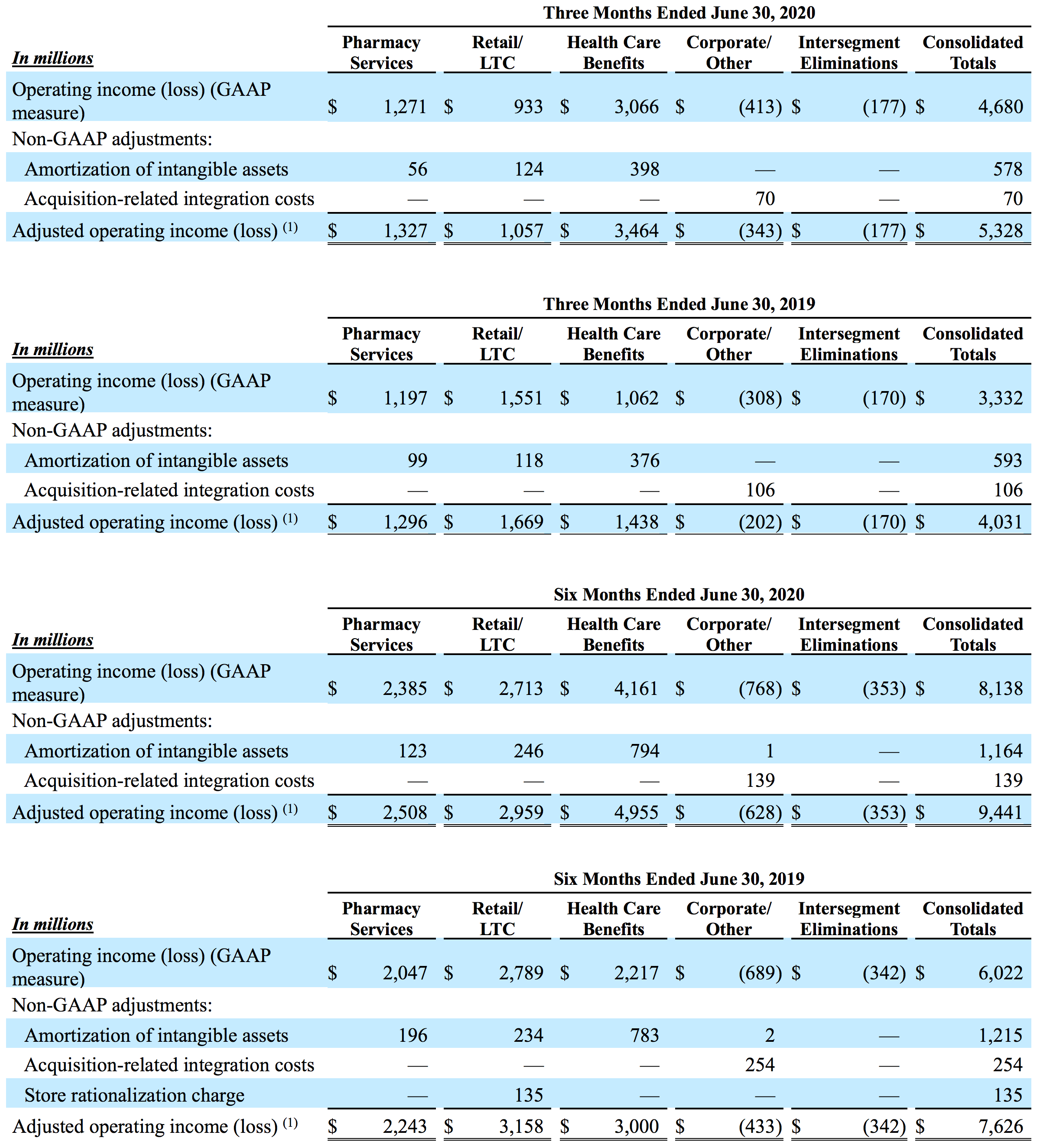
Adjusted Earnings Per Share
(Unaudited)
The following are reconciliations of net income attributable to CVS Health to adjusted income attributable to CVS Health and calculations of GAAP diluted EPS and Adjusted EPS:
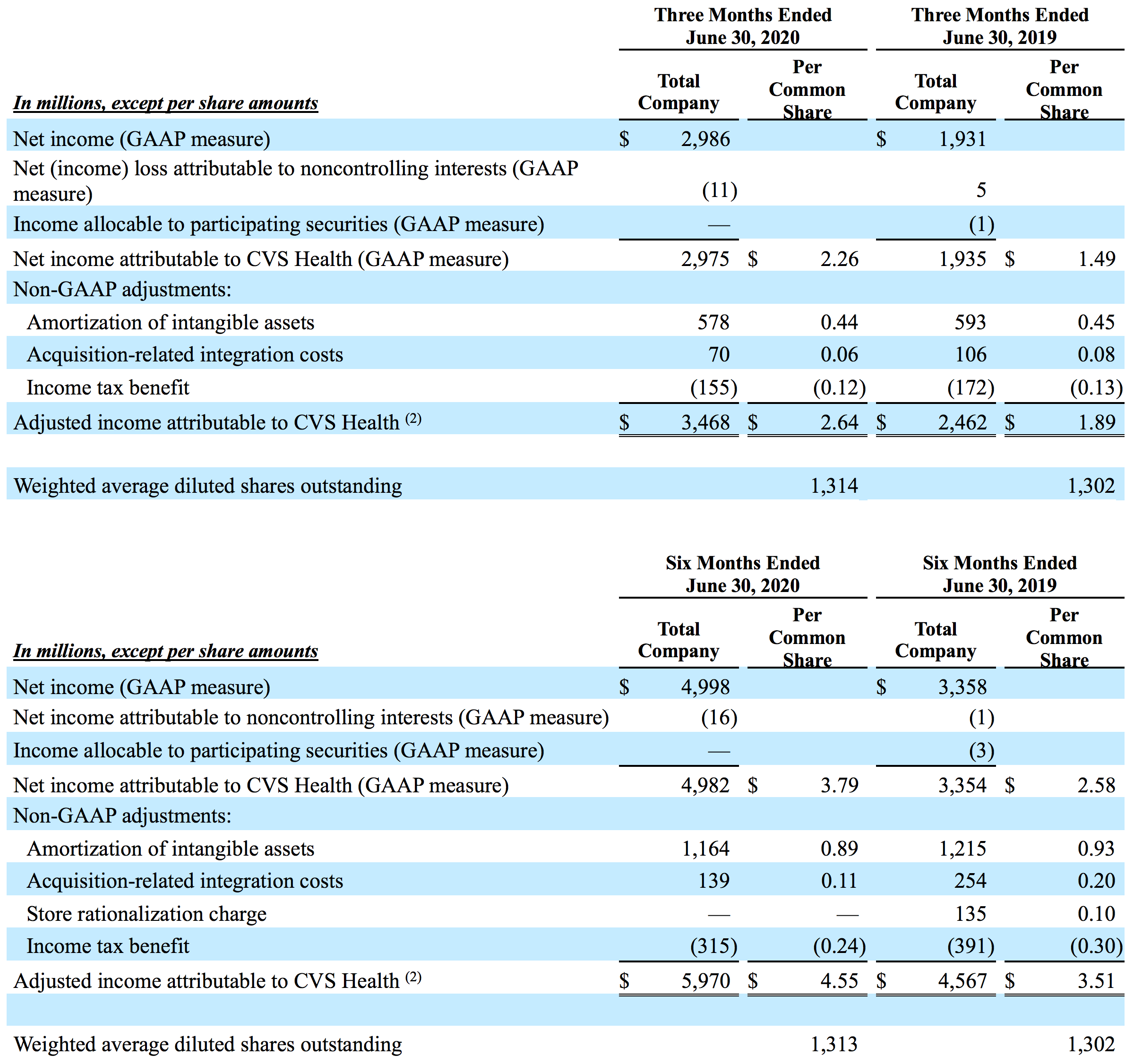
Supplemental Information
(Unaudited)
The Company’s segments maintain separate financial information, and the Company’s chief operating decision maker (the “CODM”) evaluates the segments’ operating results on a regular basis in deciding how to allocate resources among the segments and in assessing segment performance. The CODM evaluates the performance of the Company’s segments based on adjusted operating income, which is defined as operating income (GAAP measure) excluding the impact of amortization of intangible assets and other items, if any, that neither relate to the ordinary course of the Company’s business nor reflect the Company’s underlying business performance as further described in endnote (1). The Company uses adjusted operating income as its principal measure of segment performance as it enhances the Company’s ability to compare past financial performance with current performance and analyze underlying business performance and trends.
The following is a reconciliation of financial measures of the Company’s segments to the consolidated totals:
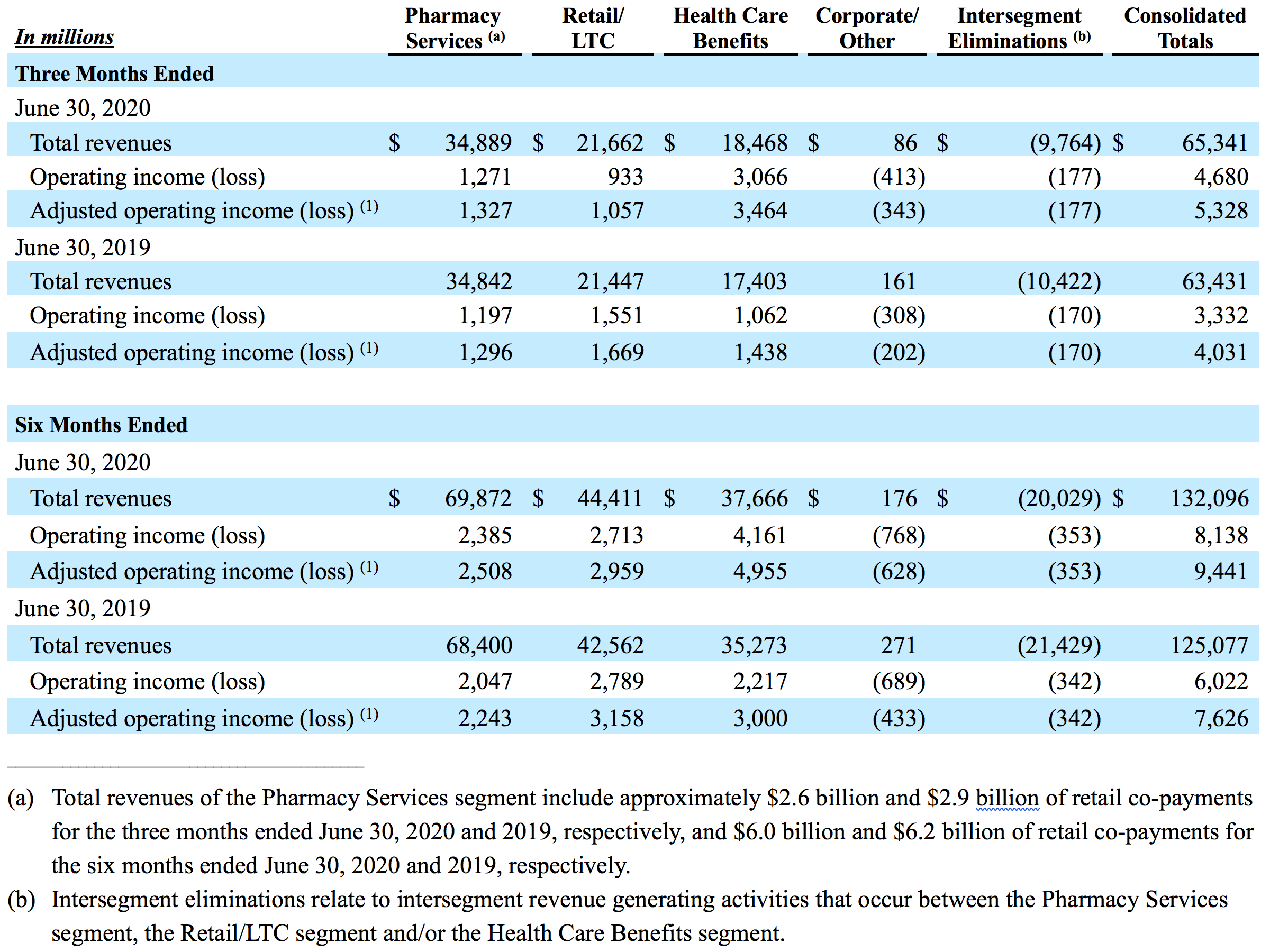
Pharmacy Services Segment
The following table summarizes the Pharmacy Services segment’s performance for the respective periods:
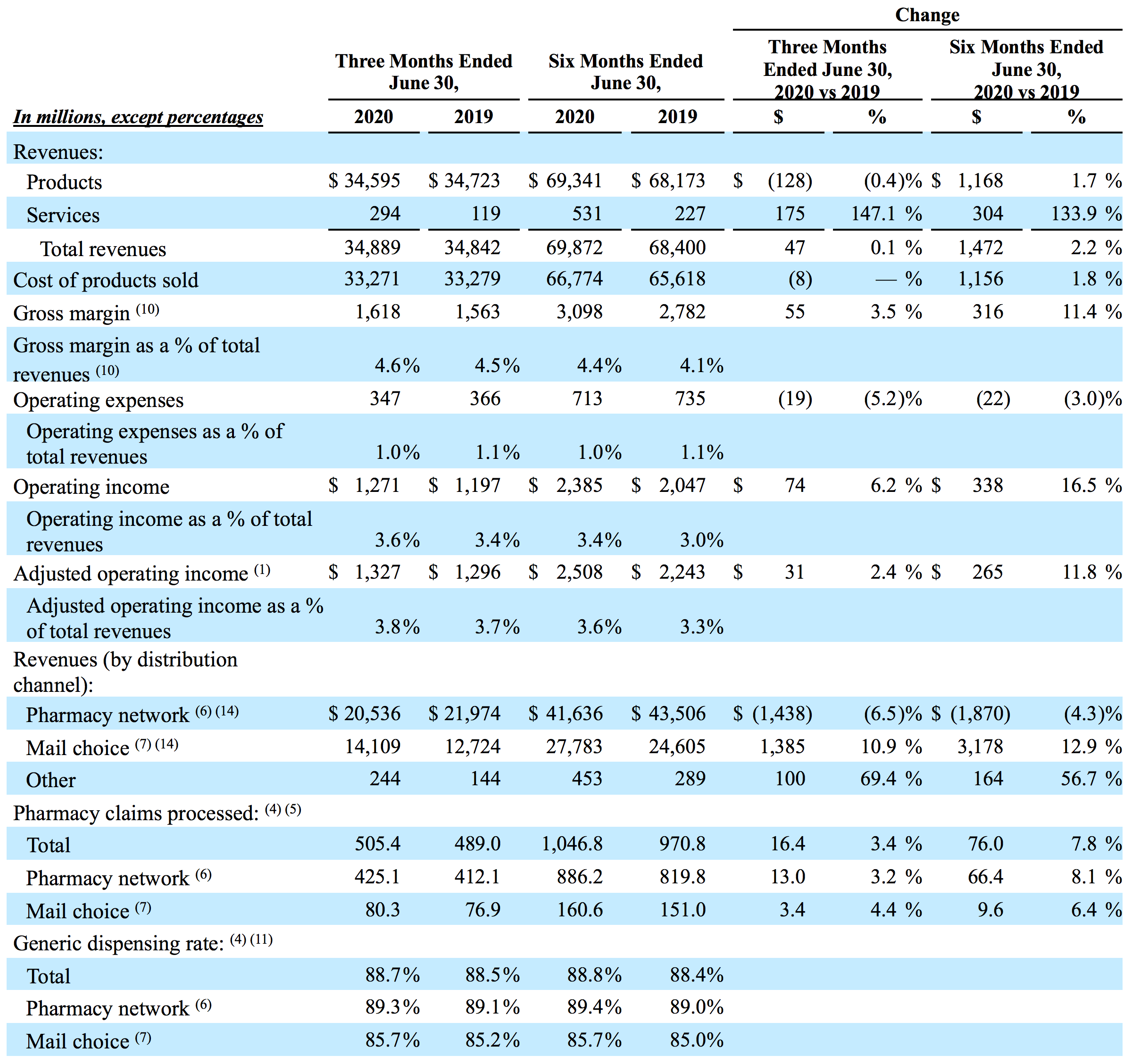
Retail/LTC Segment
The following table summarizes the Retail/LTC segment’s performance for the respective periods:
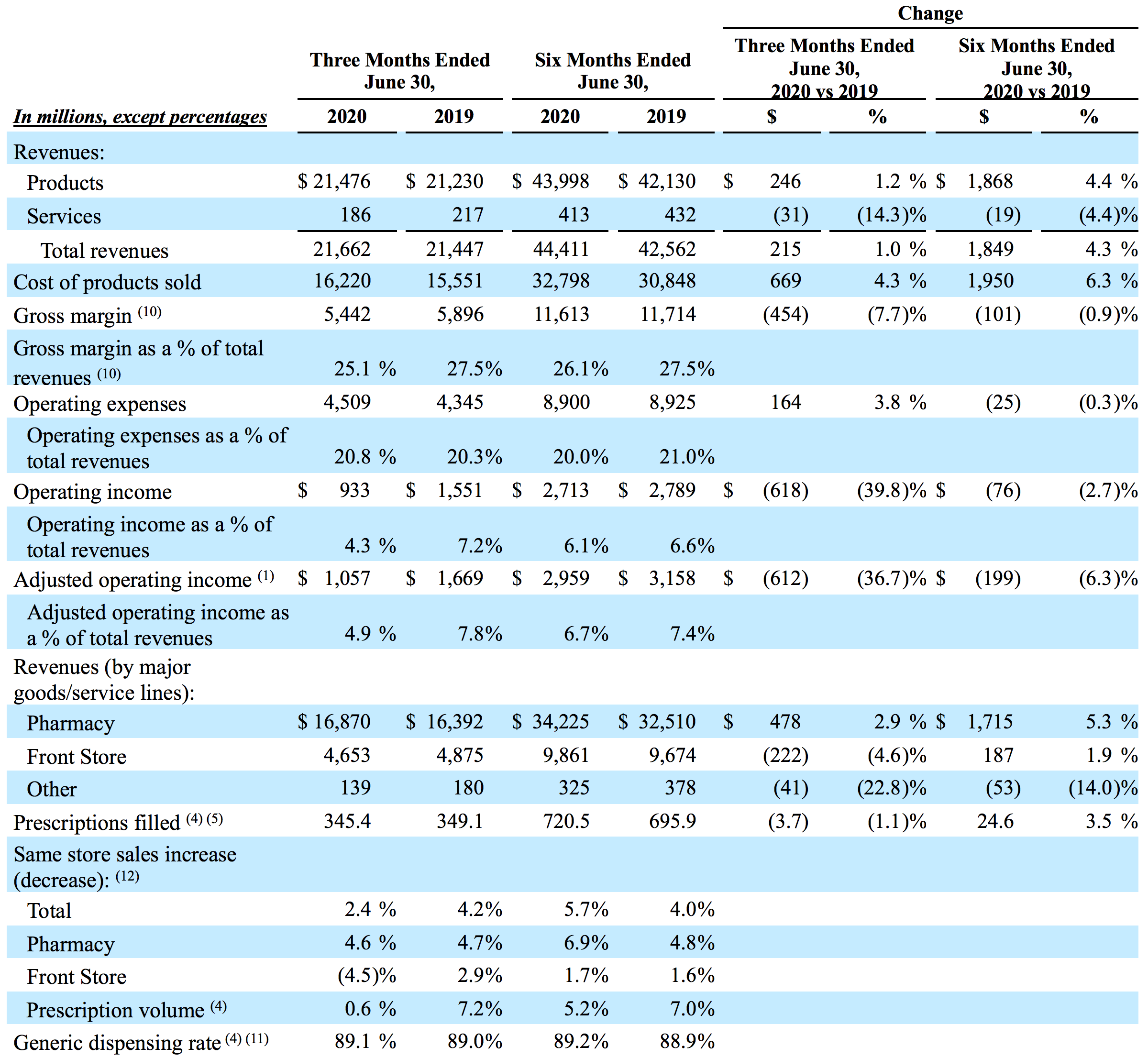
Health Care Benefits Segment
The following table summarizes the Health Care Benefits segment’s performance for the respective periods:
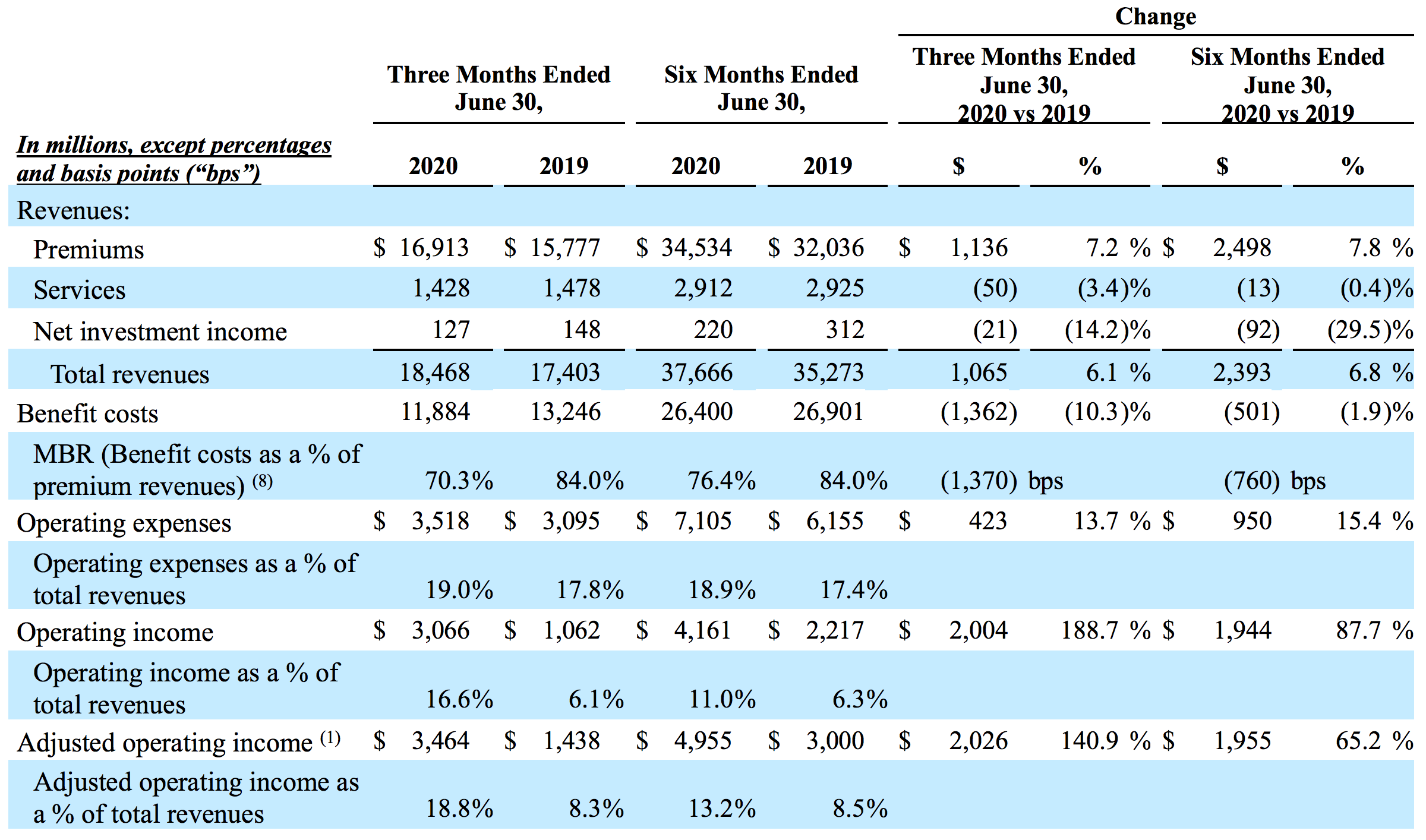
The following table summarizes the Health Care Benefits segment’s medical membership for the respective periods:
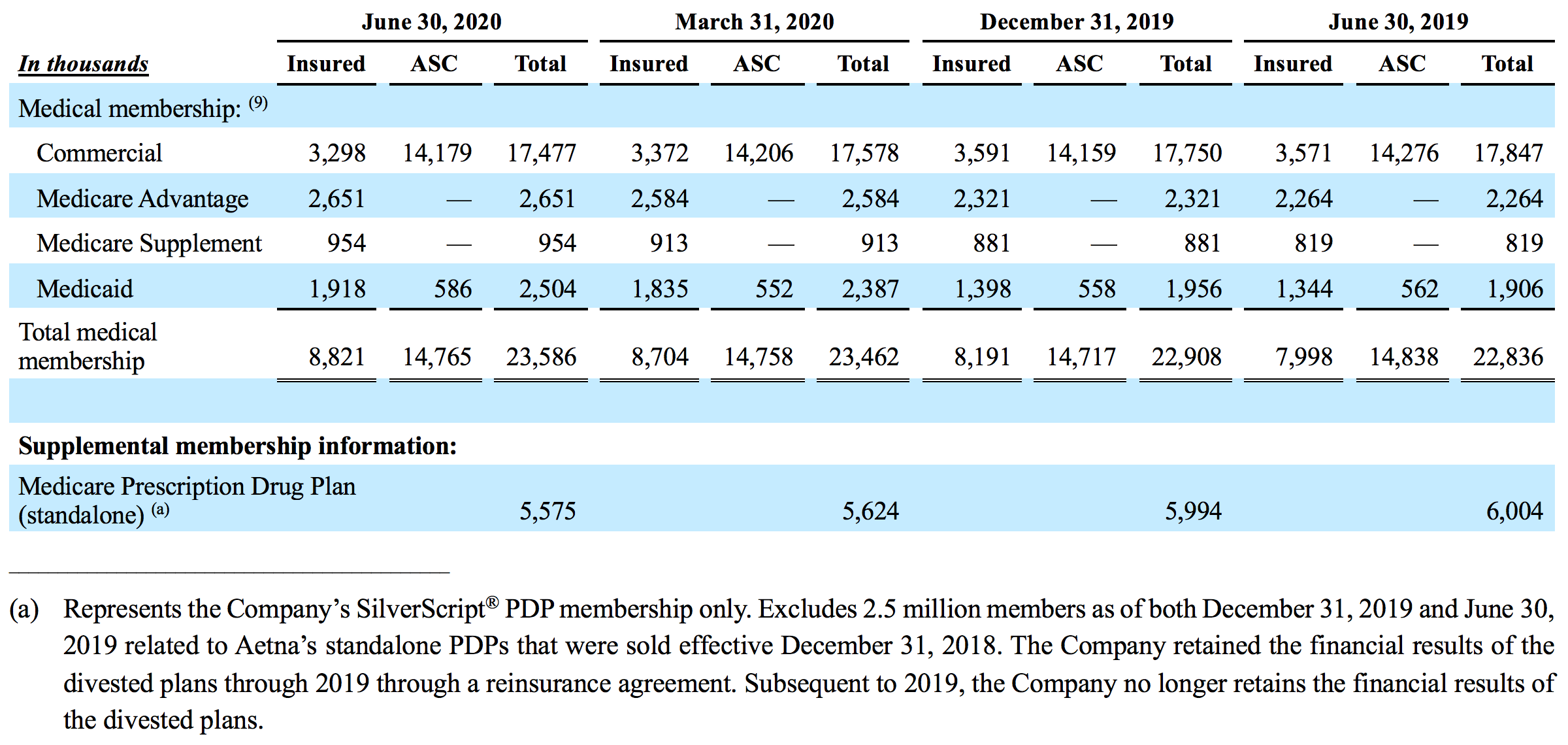
The following table shows the components of the change in health care costs payable during the six months ended June 30, 2020 and 2019:
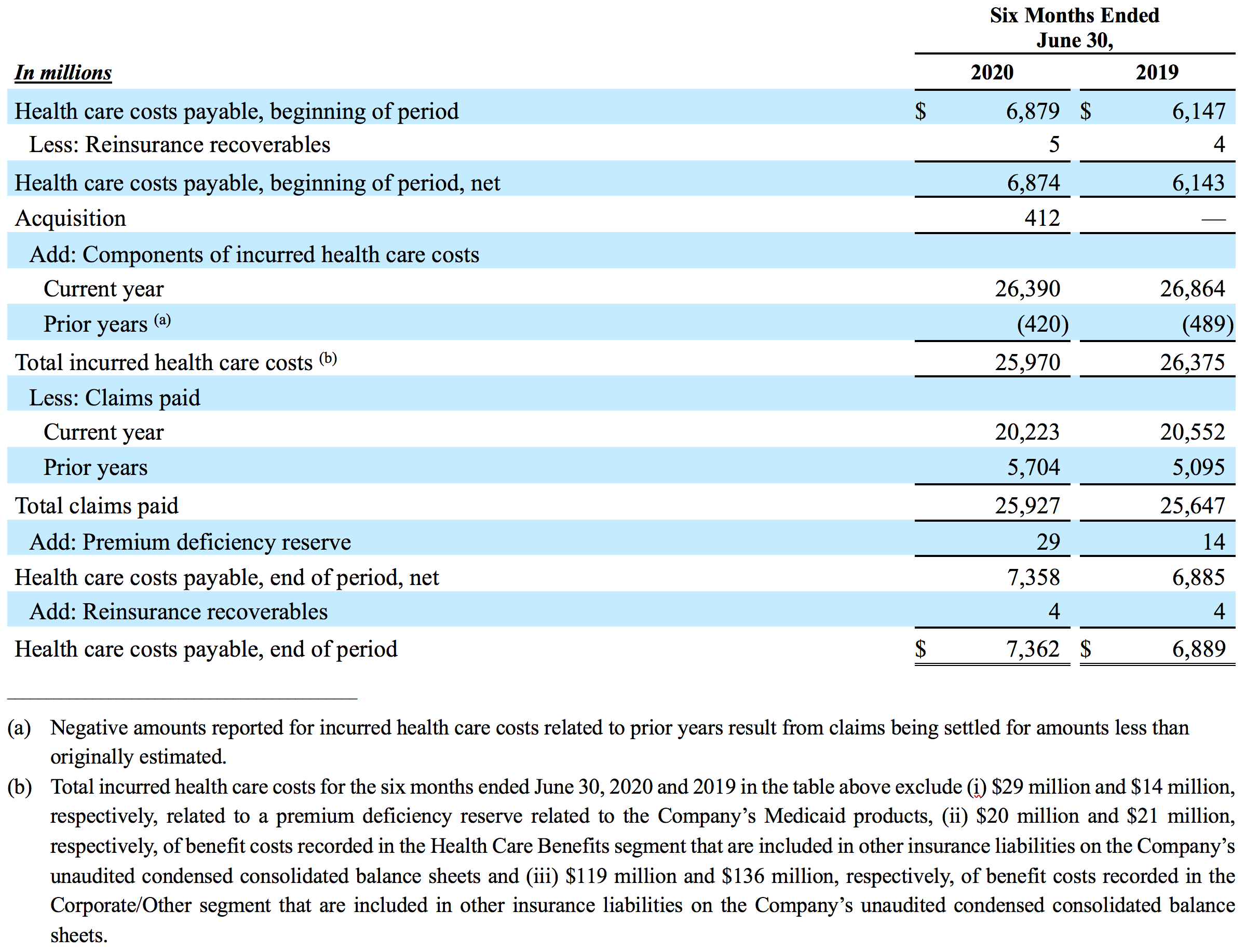
The following table summarizes the Health Care Benefits segment’s days claims payable for the respective periods:

Corporate/Other Segment
The following table summarizes the Corporate/Other segment’s performance for the respective periods:
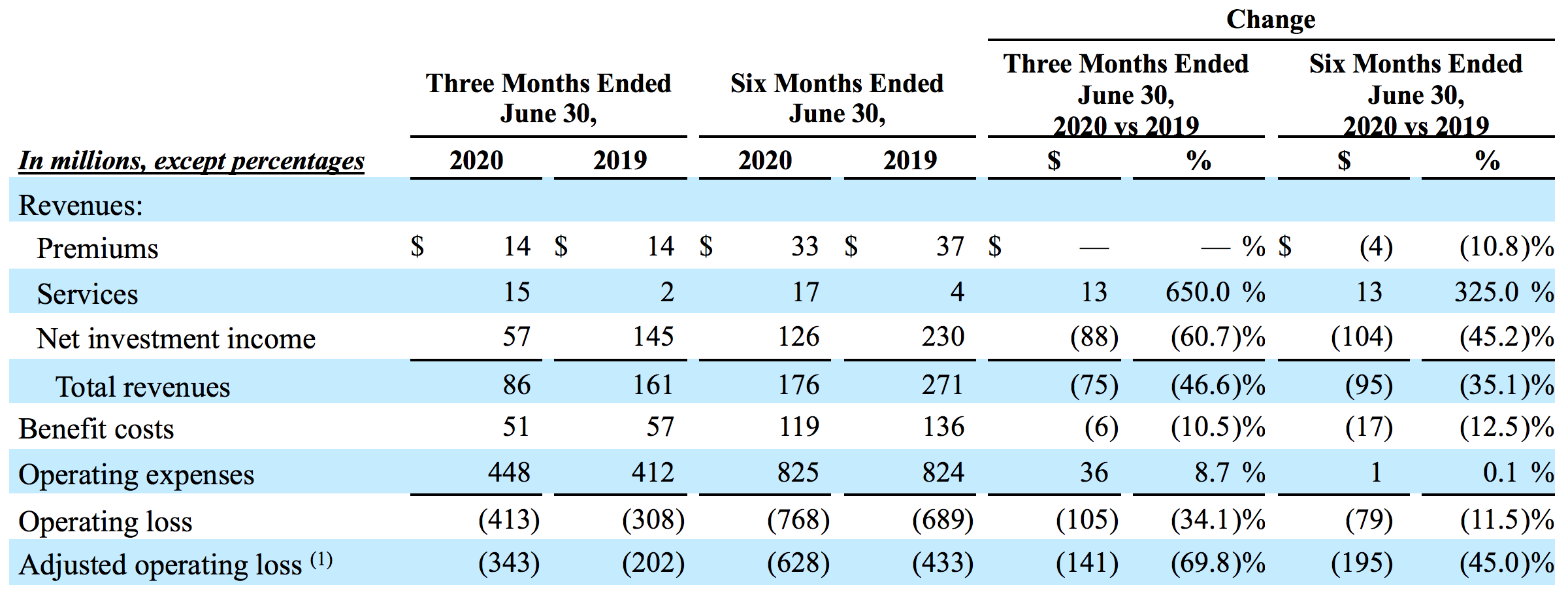
Adjusted Earnings Per Share Guidance
(Unaudited)
The following reconciliations of projected net income to projected adjusted income attributable to CVS Health and calculations of projected GAAP diluted EPS and projected Adjusted EPS contain forward-looking information. All forward-looking information involves risks and uncertainties. Actual results may differ materially from those contemplated by the forward-looking information due to the risks and uncertainties related to the COVID-19 pandemic, the severity and duration of the pandemic, the pandemic’s impact on the U.S. and global economies and consumer behavior and health care utilization patterns, and the timing, scope and impact of stimulus legislation and other federal, state and local governmental responses to the pandemic, as well as the risks and uncertainties described in our SEC filings, including those set forth in the Risk Factors section and under the heading “Cautionary Statement Concerning Forward-Looking Statements” in our most recently filed Annual Report on Form 10-K, our Quarterly Report on Form 10-Q for the quarterly period ended June 30, 2020 and our recently filed Current Reports on Form 8-K. See “Non-GAAP Financial Information” earlier in this press release and endnote (2) later in this press release for more information on how we calculate Adjusted EPS.

Endnotes
(1) The Company defines adjusted operating income as operating income (GAAP measure) excluding the impact of amortization of intangible assets and other items, if any, that neither relate to the ordinary course of the Company’s business nor reflect the Company’s underlying business performance, such as acquisition-related integration costs, store rationalization charges, gains/losses on divestitures and any other items specifically identified herein. See “Non-GAAP Financial Information” earlier in this press release for additional information regarding the items excluded from operating income.
(2) The Company defines adjusted income attributable to CVS Health as net income attributable to CVS Health (GAAP measure) excluding the impact of amortization of intangible assets and other items, if any, that neither relate to the ordinary course of the Company’s business nor reflect the Company’s underlying business performance, such as acquisition-related integration costs, store rationalization charges, gains/losses on divestitures, the corresponding income tax benefit or expense related to the items excluded from adjusted income attributable to CVS Health, and any other items specifically identified herein. GAAP diluted EPS and Adjusted EPS, respectively, are calculated by dividing net income attributable to CVS Health and adjusted income attributable to CVS Health by the Company’s weighted average diluted shares outstanding. See “Non-GAAP Financial Information” earlier in this press release for additional information regarding the items excluded from net income attributable to CVS Health and GAAP diluted EPS.
(3) Enterprise prescriptions include prescriptions dispensed through the Company’s retail pharmacies, long-term care pharmacies, and mail order pharmacies as well as prescription claims managed through our pharmacy benefits manager, with an elimination for managed prescription claims filled through CVS Health dispensing channels. Management uses this metric to analyze the total prescription volume across the Company including variances between actual prescriptions and expected amounts as well as trends in period-over-period results. This metric provides management and investors with information useful in understanding the impact of prescription volume on total revenues and operating results.
(4) Includes an adjustment to convert 90-day prescriptions to the equivalent of three 30-day prescriptions. This adjustment reflects the fact that these prescriptions include approximately three times the amount of product days supplied compared to a normal prescription.
(5) Total pharmacy claims processed represents the number of prescription claims processed through our pharmacy benefits manager and dispensed by either our retail network pharmacies or our own mail and specialty pharmacies. Prescriptions filled represents the number of prescriptions dispensed through the Retail/LTC segment’s pharmacies. Management uses these metrics to understand variances between actual claims processed and prescriptions dispensed, respectively, and expected amounts as well as trends in period-over-period results. These metrics provide management and investors with information useful in understanding the impact of pharmacy claim volume and prescription volume, respectively, on segment total revenues and operating results.
(6) Pharmacy network is defined as claims filled at retail and specialty retail pharmacies, including the Company’s retail pharmacies and long-term care pharmacies, but excluding Maintenance Choice activity, which is included within the mail choice category. Maintenance Choice permits eligible client plan members to fill their maintenance prescriptions through mail order delivery or at a CVS Pharmacy retail store for the same price as mail order.
(7) Mail choice is defined as claims filled at a Pharmacy Services mail order facility, which includes specialty mail claims inclusive of Specialty Connect® claims picked up at a retail pharmacy, as well as prescriptions filled at the Company’s retail pharmacies under the Maintenance Choice program.
(8) Medical benefit ratio is calculated as benefit costs divided by premium revenues and represents the percentage of premium revenues spent on medical benefits for the Company’s insured members. Management uses MBR to assess the underlying business performance and underwriting of its insurance products, understand variances between actual results and expected results and identify trends in period-over-period results. MBR provides management and investors with information useful in assessing the operating results of the Company’s insured Health Care Benefits products.
(9) Medical membership represents the number of members covered by the Company’s insured and ASC medical products and related services at a specified point in time. Management uses this metric to understand variances between actual medical membership and expected amounts as well as trends in period-over-period results. This metric provides management and investors with information useful in understanding the impact of medical membership on segment total revenues and operating results.
(10) Gross margin is calculated as the segment’s total revenues less its cost of products sold. Gross margin as a percentage of total revenues is calculated by dividing the segment’s gross margin by its total revenues and represents the percentage of total revenues that remains after incurring direct costs associated with the segment’s products sold and services provided. Gross margin as a percentage of total revenues provides investors with information that may be useful in assessing the operating results of the Company’s Pharmacy Services and Retail/LTC segments.
(11) Generic dispensing rate is calculated by dividing the segment’s generic drug prescriptions processed or filled by its total prescriptions processed or filled. Management uses this metric to evaluate the effectiveness of the business at encouraging the use of generic drugs when they are available and clinically appropriate, which aids in decreasing costs for client members and retail customers. This metric provides management and investors with information useful in understanding trends in segment total revenues and operating results.
(12) Same store sales and prescription volume represent the change in revenues and prescriptions filled in the Company’s retail pharmacy stores that have been operating for greater than one year, expressed as a percentage that indicates the increase or decrease relative to the comparable prior period. Same store metrics exclude revenues from MinuteClinic®, revenues and prescriptions from LTC operations and, in 2019, revenues and prescriptions from stores in Brazil. Management uses these metrics to evaluate the performance of existing stores on a comparable basis and to inform future decisions regarding existing stores and new locations. Same-store metrics provide management and investors with information useful in understanding the portion of current revenues and prescriptions resulting from organic growth in existing locations versus the portion resulting from opening new stores.
(13) Days claims payable is calculated by dividing the health care costs payable at the end of each quarter by the average health care costs per day during such quarter. Management and investors use this metric as an indicator of the adequacy of the Company’s health care costs payable liability at the end of each quarter and as an indicator of changes in such adequacy over time.
(14) Certain prior year amounts have been reclassified for consistency with the current period presentation.